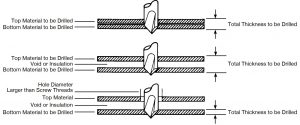CSK Self-Drilling Screws
A Self-Drilling Screw is a Self-Tapping Screw with the added feature of a drill point. The drill point looks a lot like the point of a drill. It will drill a hole and form the mating threads in one operation.
A wafer head is unique.
Materials
- Carbon Steel
- Stainless Steel AISI-304
- Stainless Steel AISI-316
- BiSS-304 with Carbon Steel Drill point.
- Stainless Steel AISI-410
Finish/Coating
- Zinc Electroplated
- Class-3 Coating
- Passivated

WAFER HEAD WITH PHILLIPS
Truss with Phillips
Special Considerations
Flute Length – The length of the flute determines the thickness of the metal that self-drilling screw can be used on. The flute is designed to extract the drilled material from the hole.
If the flute becomes blocked cutting will stop. Simply put if you have are attaching thick pieces of material together then you will require a self-drilling screw with a flute to match. If the flute becomes blocked and you take no action the drill point will likely overheat and fail.

Drill-Point Material is generally plain carbon steel which is less stable at high temperatures than equivalent high-speed steel (HSS) drill-bits. To reduce wear on the drill point, fasten using a drill motor rather than an impact driver or hammer drill.
High Temperature Stability affects how quickly the drill point fails due to the heat generated by the drilling operation. Refer to the troubleshooting guide at the end of this section for some visual examples.
Drilling Temperature is directly proportional to motor RPM, applied force, and work material hardness. As each value increases, so does the heat generated by the drilling operation.
Reducing Applied Force can increase durability and allow the drill point to penetrate thicker materials (i.e., remove more material before failing due to heat buildup).
Reducing Motor RPM can improve performance in harder materials by allowing the user to push harder during the drilling process and extending the life of the drill point.

Winged and non-winged
It is recommended to use self-drilling screws with wings when fastening wood over 12 mm thick to metal.
The wings will ream a clearance hold and keep the threads from engaging too early.
When the wings engage with the metal they will break off allowing the threads to engage into the metal. If threads engage too early this will cause the two materials to separate.
Caution
It is a common error in assuming that Stainless Steel Self Drilling Screws will drill into steel. However, that is not the case. To provide corrosion resistance, stainless steel self-drill screws are made from AISI-304 or AISI-316 grades. These cannot be hardened and therefore the drill point can only drill into softer materials like Aluminium.
Self-drilling screw trouble shooting guide
| Failure Type | Cause of failure |
|---|---|
Flutes chipped |
Excess force used when driving the screw in |
No drilled hole |
Material too hard Driver set to reverse Blunt drill point due to handling or a manufacturer defect |
Flute melted |
Material too hard Too high RPMs used |
Melted point |
Material too hard Excess force used |
Drill bit split |
Excess force used when driving the screw in |
